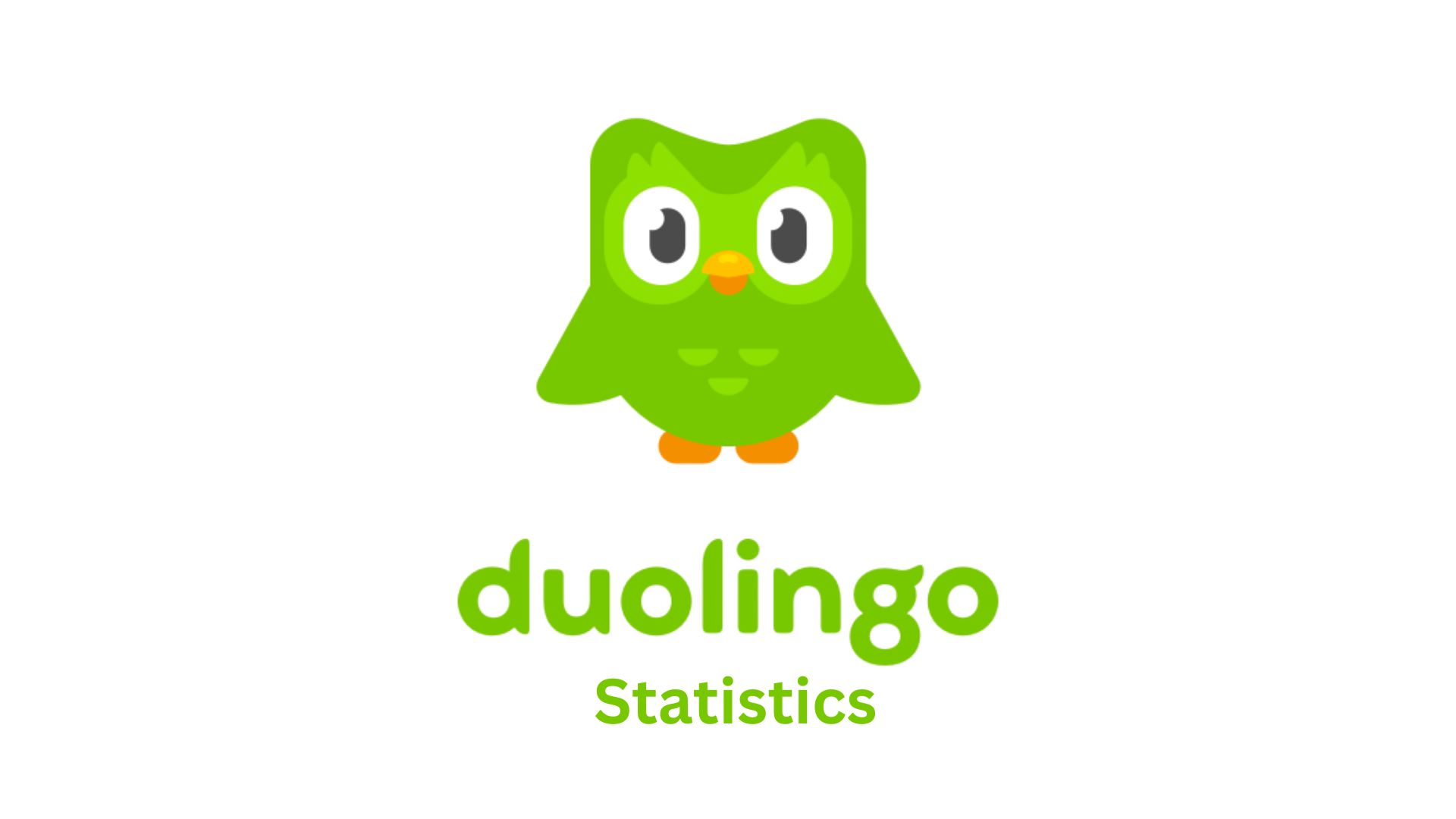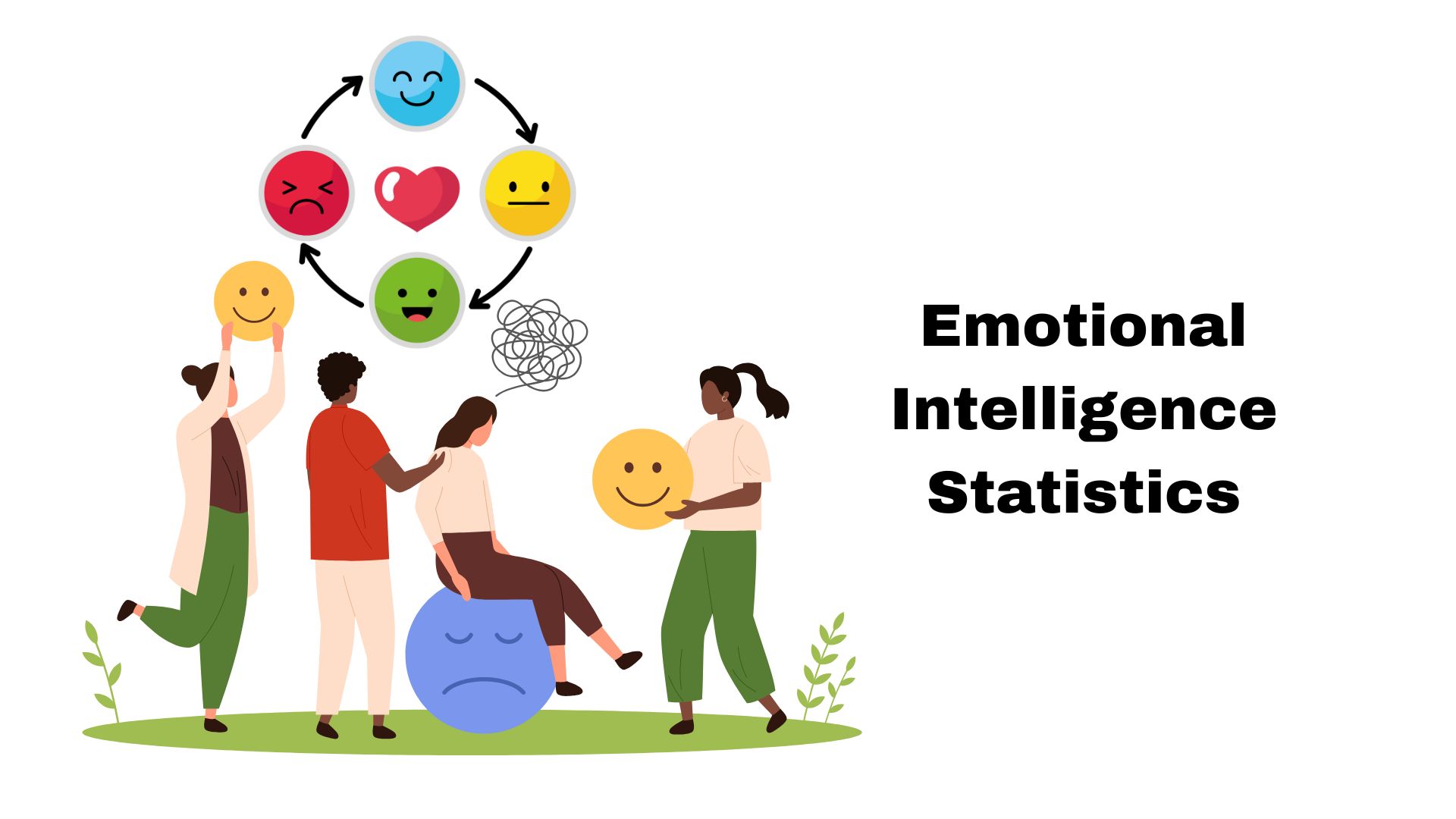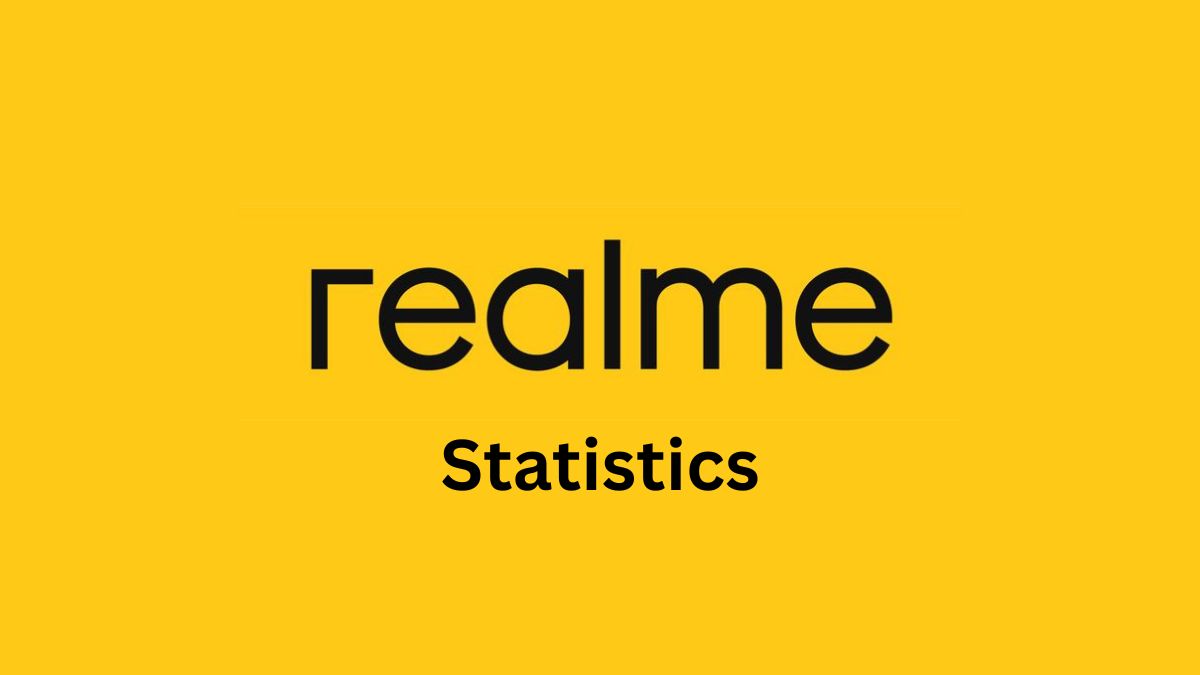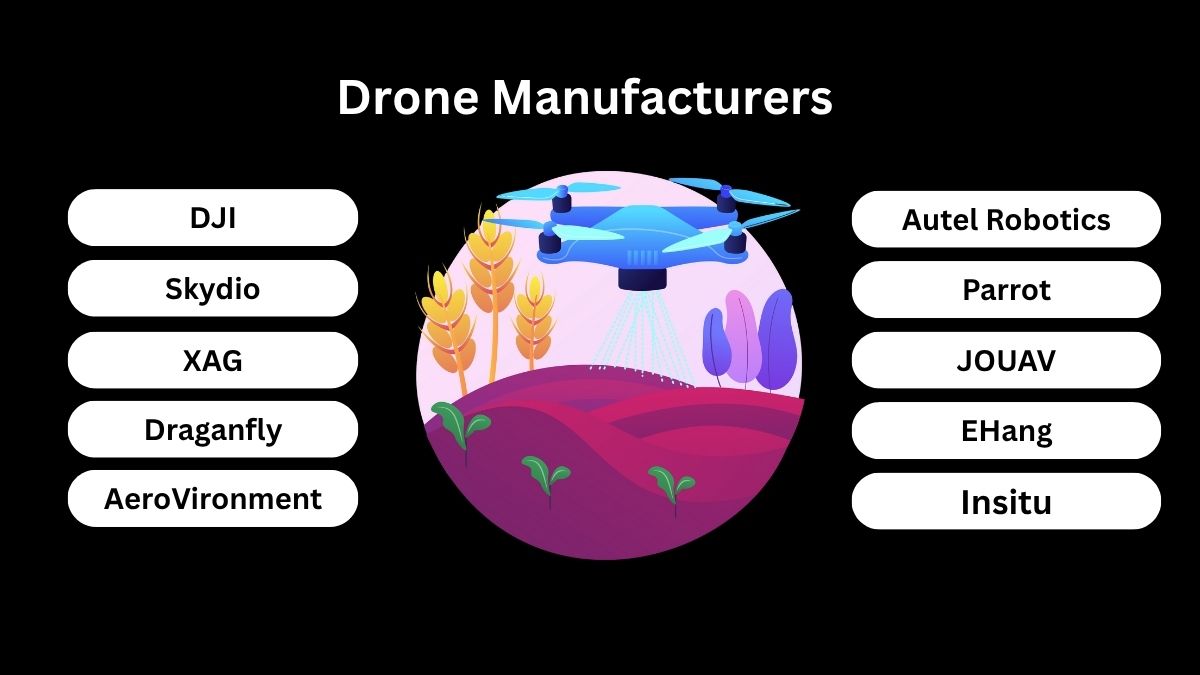Stack Overflow Statistics And Facts (2025)
Updated · Sep 24, 2025
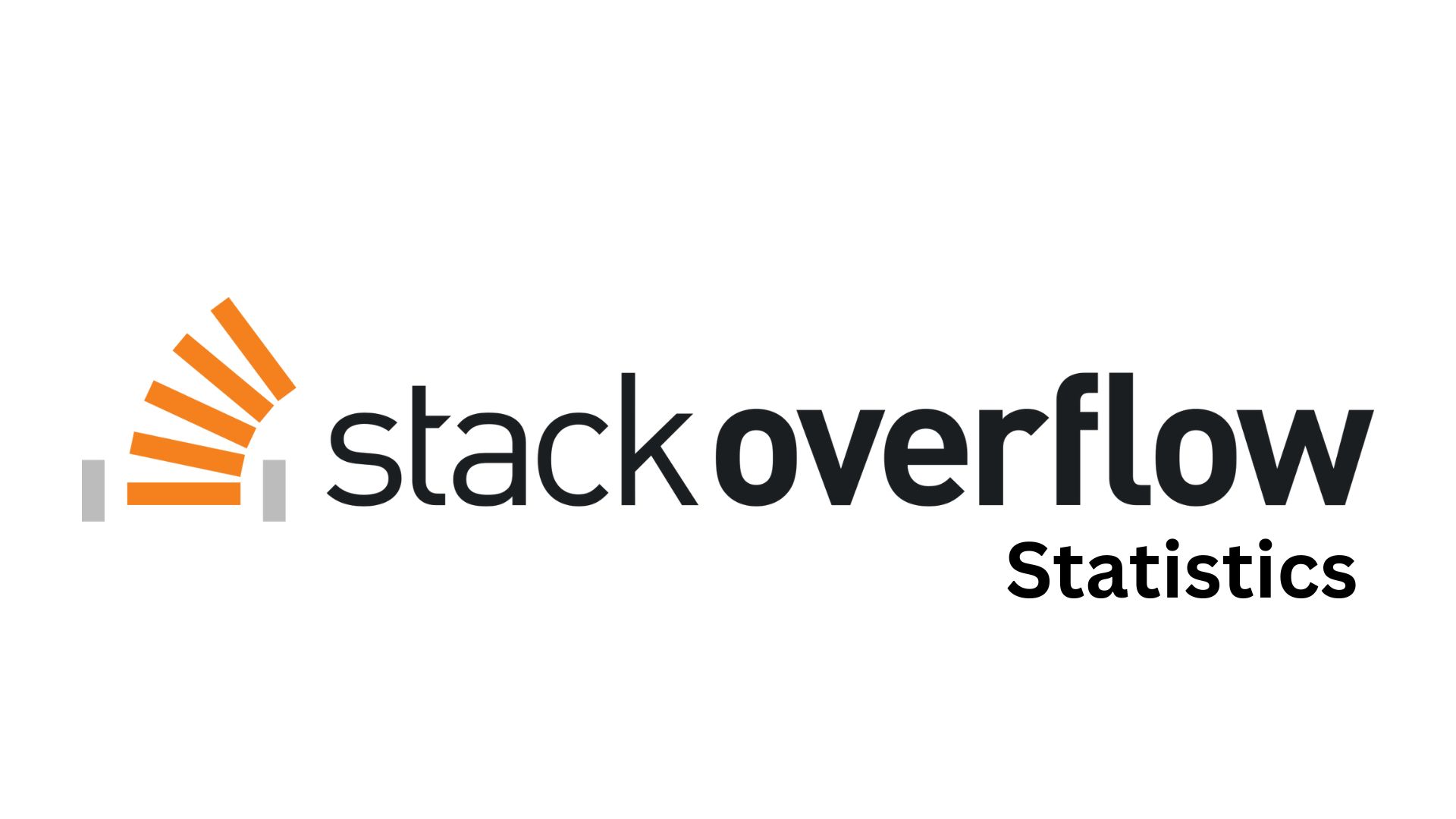
Table of Contents
- Introduction
- Editor’s Choice
- Most Popular Uses Of AI In The Development Workflow Among Developers
- Most Popular Resources For Learning Coding Among Developers worldwide, 2024, By Age
- Stack Developer Embedded Technologies
- Demographics And Experience
- Learning Resources
- Technology And Tools
- AI Adoption And Sentiments
- Work And Employment
- Stack Overflow Developer Salaries And Compensation
- Conclusion
Introduction
Stack Overflow Statistics: The 2024 Stack Overflow Developer Survey offers a comprehensive snapshot of the global developer community, compiling insights from 65,437 respondents across 185 countries. Conducted between May 19 and June 20, 2024, the survey had a median completion time of approximately 21 minutes.
A significant 76% of developers reported using or planning to use AI tools in their development processes, marking an increase from 70% in 2023. However, trust in AI tool accuracy remains divided, with only 43% expressing confidence in their outputs. Despite this, 81% of developers identified increased productivity as the primary benefit of integrating AI tools into their workflows.
Educational backgrounds among respondents show that 66% hold a Bachelor’s or Master’s degree, even though only 49% learned to code through formal education.
Geographically, the United States accounted for 18.9% of respondents, followed by Germany at 8.4% and India at 7.2%, highlighting the survey’s extensive international reach.
This year’s survey underscores the evolving landscape of software development, emphasizing the growing integration of AI tools, the shift towards self-directed learning, and the diverse global composition of the developer community.
This article will highlight the Stack Overflow statistics and its performance.
Editor’s Choice
- The 2024 Stack Overflow Developer Survey includes 65,437 respondents from 185 countries, providing a detailed snapshot of the developer community worldwide.
- About 82% of developers use AI tools for writing code, and another 68% use AI for seeking answers to questions, thereby making AI more relevant in day-to-day development work.
- Video and blogging are preferred ways to learn coding among online resources, mostly for younger developers. Nearly half (54%) of 25-to-34-year-olds and most (52%) of 35-to-44-year-olds prefer taking courses or securing certifications online.
- The top three programming languages were JavaScript (62%), HTML/CSS (53%), and Python (51%), with Python also being the desired language to code in the future.
- The largest segment covered was those aged between 25-34, comprising 37%, followed generationally by 18-24 years at 21.4%.
- 38% of developers indicate more than 15 years of coding experience, and one-third have less than four years of experience in the profession.
- 49% learned how to code away from the classroom, whereas 66% also report having bachelor’s or master’s degrees.
- API and SDK documentation comprise 90% of the developers’ essential learning resource.
- PostgreSQL is the most widely used relational database among developers, with a share of 49%.
- Docker is used by 59% of professional developers, which confirms its importance in DevOps.
- 76% of developers are using AI tools or intend to use them, compared to 70% last year at this time.
- 81% refers to a gain in productivity, and 62.4% refers to heightened speed of learning for the most significant benefits from AI tools.
- The most important ethical concerns about AI are misinformation (79.4%) and lack of source attribution (64.7%).
- 84% of developers surveyed are working full time, part time, or freelance.
- 42% of personnel work in hybrid environments, and 20% reported working only in-person compared to 16% last year.
- Only 19% are happy with their jobs, and 48% feel they are somewhat happy.
- Senior executives earn the highest average salary at US$225,000, followed by engineering managers at US$192,500.
- Backend developers earn US$170,000, while mobile developers earn US$185,000 and cloud engineers earn US$165,000.
- Developers in the front end, full-stack, and embedded earn between US$130,000-135,000.
- Those using Erlang and Clojure earn more than US$95,000, while those who code with Dart and Prologue earn less than US$45,000.
Most Popular Uses Of AI In The Development Workflow Among Developers
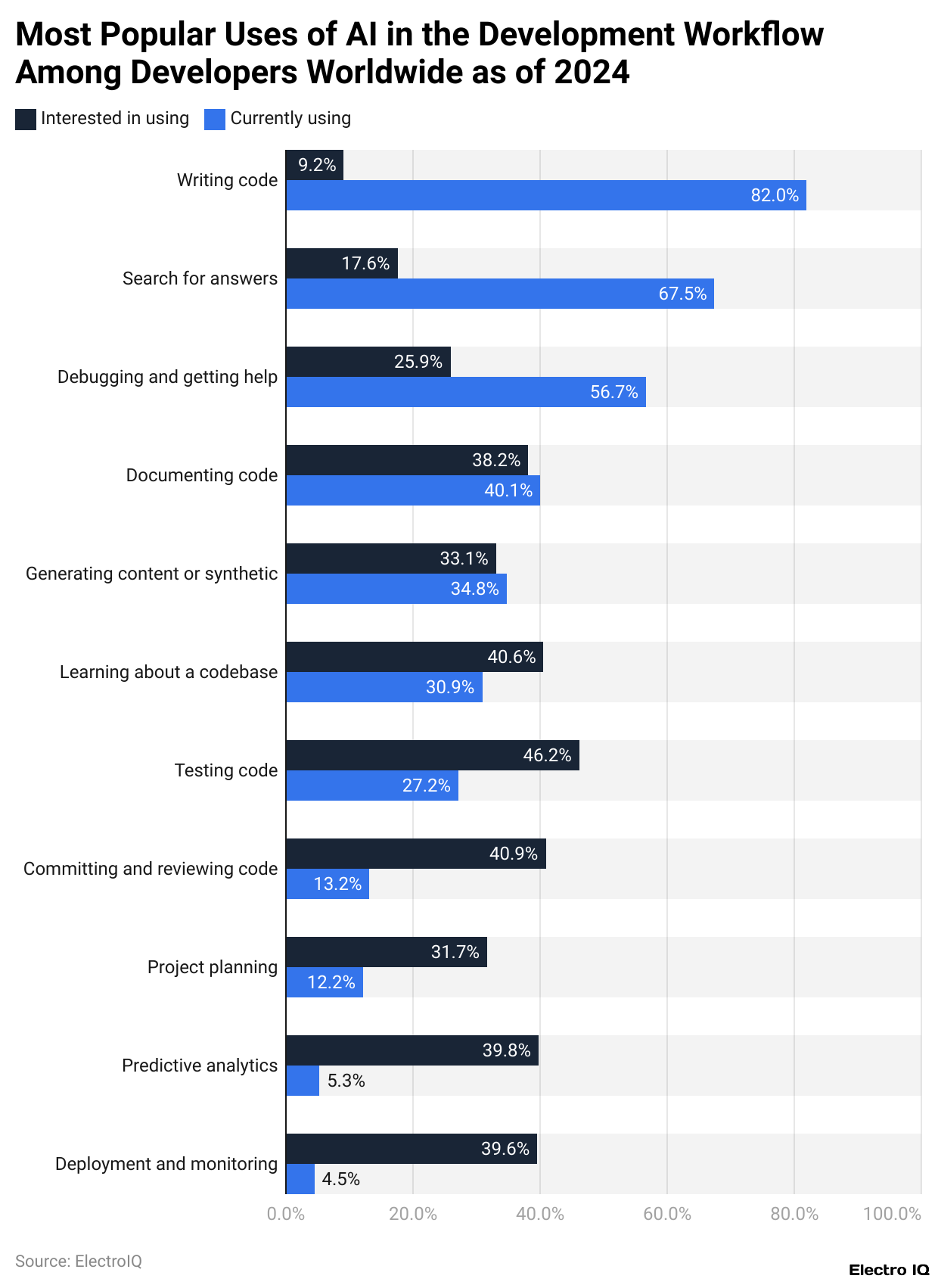
(Reference: statista.com)
- As per the Stack Overflow statistics Survey 2024, about 82 % of developers indicated that they are using AI tools to actively help them during the process of writing code.
- Indeed, the number soars in terms of the general activity in the workflow where AI seems to hold a surefire sway on the day-to-day tasks empowered by an individual.
- Rather, only a little over half of developers reported using AI tools for such purposes, with most of them stating that they are used to find answers.
- The case-offs, therefore, capture the new provision happening here: developers have begun using AI not only for the assistance of coding but also as a hasty mode of finding solutions.
Most Popular Resources For Learning Coding Among Developers worldwide, 2024, By Age
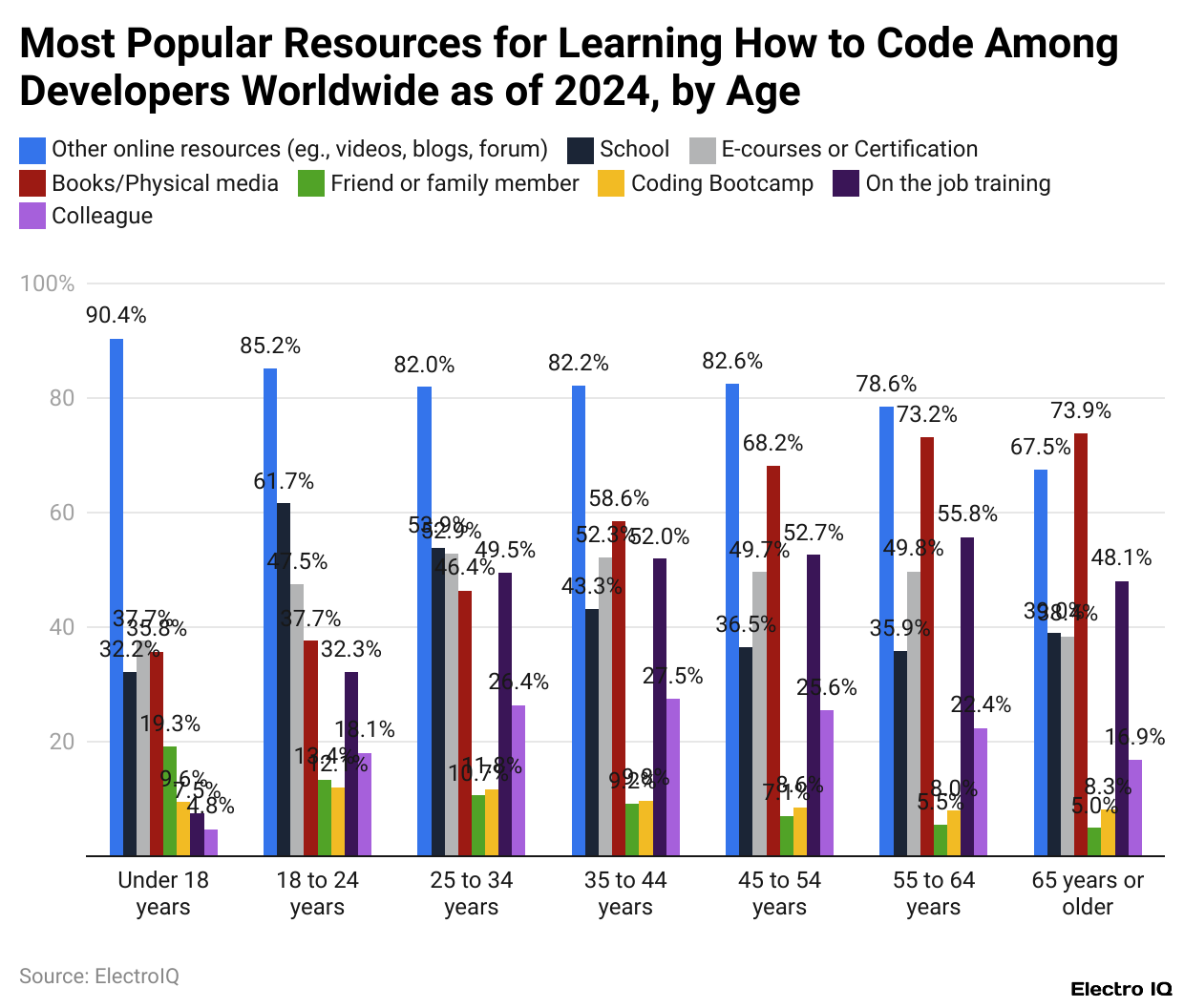
(Reference: statista.com)
- The Stack Overflow statistics survey for 2024 states that, among all ages, learning coding from online sites like videos, blogs, and forums is the preference for developers.
- These were the top resources for anyone, but the younger developers were relatively more inclined to adopt these methods. Next among the preferences was enrolling in online courses or certifications.
- By this method, the 25-34-year-olds favored it the most, with 54 % opting for it, while 52% in the group 35-44 chose this option.
- On the contrary, books and other hard copies are, for the most part used by developers aged 25 and older, meaning that older age groups keep more distance from traditional formats of learning in comparison to younger ones.
Stack Developer Embedded Technologies
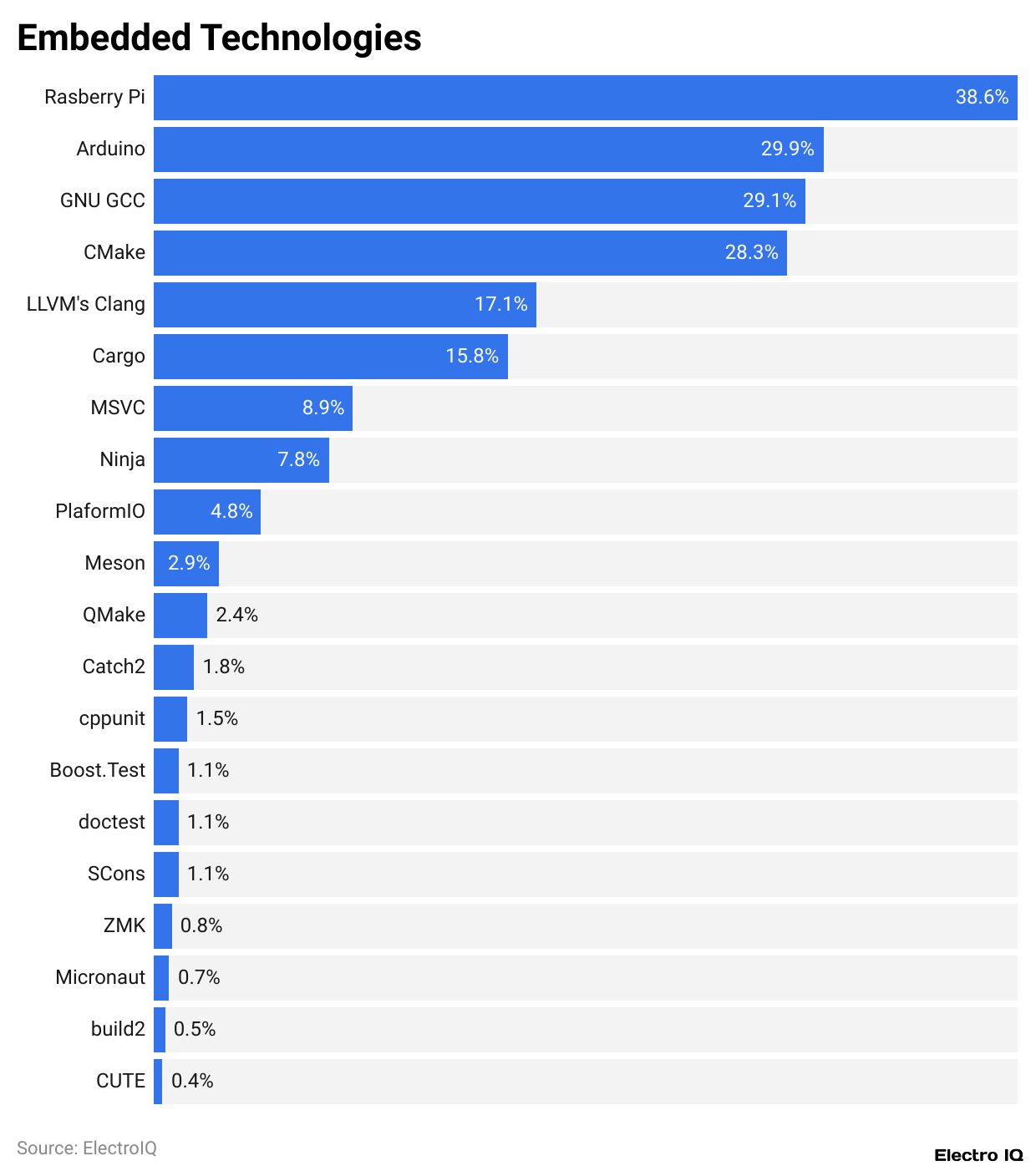
(Reference: stackoverflow.blog)
- Long-established tools in the developer community have shown remarkable staying power, thus continuing the tradition of the Stack Overflow statistics survey 2024, covering an even larger breadth of technologies.
- JavaScript (62%), HTML/CSS (53%), and Python (51%) have been the most used programming languages, reserved for use for the second year in a row.
- Most probably, JavaScript lives on through its name on account of being the most popular language since the very first Developer Survey.
- Whereas Python now steals the number-one spot from JavaScript for actual usage among devs who are not actually using it, yet heavily desire to get it working in their project next year.
- Rust occupies the second term of rulership as the most loved language, where 83% of its users want to work with it again.
- Interestingly, Python also became the most-loved language for those who started learning it this year.
- More interesting is that these learners expressed a willingness to try out about 12 different programming languages in the following 12 months, indicating enthusiasm and the exploratory nature of early learning.
- Stack Overflow statistics state that the embedded technologies section was new in this year’s survey, which meant to recognise a growing but still niche segment of developers, just 3% of respondents were involved in this field.
- Among these are Raspberry Pi (38.6%) and Arduino (29.9%), closely followed by GNU GCC (29.1%) as the most used embedded technology.
- Notably, the Raspberry Pi and Arduino users seem to be developing a keen interest in Cargo, a tool currently in use by 16% of embedded developers and enjoys an impressive 83% admiration score along with Rust.
- The tools are integrated with developing environments (IDEs), which often define loyalty as well as critique.
- The overall saturation and maintaining sheer might of alternatives have left Visual Studio Code and Visual Studio continuing their overall dominance as the top two most used IDEs.
- From the most encouraging interest among developers to learn new things, there comes resistance to switching their primary code editors.
- Maybe this has to do with familiarity or productivity, or some rather steep learning curve of some alternatives. If there were a case of change, most developers would handpick Neovim as a potential contender.
- Neovim enjoys an 83% admiration rating and is among the very few editors that Visual Studio Code users are seriously considering trying next, along with Vim.
- This knowledge presents a developer community that keeps score on innovation versus reliability, is open to new tools but measured in their uptake, and values technologies that harmonise power with efficiency and strong community support.
Demographics And Experience
- According to Stack Overflow statistics, the majority of developers fall within the age range of 25 to 34 years. Thus, they account for 37% of the respondents. Further, another class significant enough, comprising about 21.4%, is made up of people aged from 18 to 24 years.
- Stack Overflow statistics indicate a steady pathway of young professionals coming into the tech sector.
- Approximately 38% of developers have over 15 years of coding experience; conversely, about one-third are pretty new, with less than four years of professional experience. This thus represents a wide spectrum of skill levels across the global developer community.
- While just under half of all developers (49%) learned to code formally in a school environment, a significant 66% have completed at least a bachelor’s or master’s degree.
- This emphasises the rising role of self-learning and other alternative education options in the tech industry.
Learning Resources
- Online resources such as tutorials, videos, blogs, and forums are the most frequented learning tools by 82% of the developers. These resources are widely trusted owing to their accessibility and recent information.
- API and SDK documentation are still essential resources; 90% of all developers rely on them. Their repository status and clearness make them the first resort for learning and reference.
Technology And Tools
- According to Stack Overflow statistics, with 62.3% of developers reporting using it in the previous year, JavaScript has been the most popularly used language. It continues to be the language of choice for frontend and backend.
- Rust retains its title as the most loved programming language with an 83% approval rating. Developers admire it for performance, safety, and its modern syntax.
- Postgresql is now the most popularly used database, with 49% of respondents stating they use it. Its popularity has soared over the years, signalling a decisive turn in database preference.
- Docker is still favoured by program developers, with 59% of them using it in their workflows. As a containerisation and DevOps tool, it has now attained the status of a must-have in the sphere of modern software development.
AI Adoption And Sentiments
- The use of AI tools in the software development process has seen considerable uptake recently, with 76% of developers already using or intending to use AI tools in the coming future. This is an increase over the last year, where the figure was 70%.
- While 72% of developers have a positive outlook on AI tools, this is a mild decline from 77% last year. This slight drop may be indicative of some implementation issues or failures of current technologies to meet developers’ expectations.
- According to Stack Overflow statistics, the prime benefit of AI tools is enhanced productivity, with 81% in agreement. Another 62.4% appreciate how AI tools make it easier for them to learn new technologies.
- That said, the most pressing ethical issue regarding AI is misinformation, according to 79.4% of respondents. Next, 64.7% raised the issue of lack of clear source attribution in AI content.
Work And Employment
- Stack Overflow statistics reveal that the demand for tech jobs is thriving, where 84% of developers find full-time, part-time, or freelancing engagements.
- Hybrid modes of work continue to reign, with 42% of developers working remotely, mixed with some on-site presence. In-person jobs have also experienced a slight boost from 16% to 20% in comparison to last year.
- Overall, 62% of developers state that they venture into the office at least once a week.
- While steady in terms of employment, only 19% of developers state they are very happy in their jobs; 48% say they feel indifferent or settled, signalling that many would probably consider better opportunities or work conditions.
Stack Overflow Developer Salaries And Compensation
- According to Stack Overflow statistics, in the 2024 developer compensation scenario, senior executives are topping the charts for salaries with an average of US$225,000.
- Engineering managers are just behind them with a pay packet of around US$192,500 each year.
- Among specific roles, backend developers draw pay at around US$170,000, while those specialising in mobile development enjoy even more favourable remuneration, averaging US$185,000.
- Cloud infrastructure engineer salary scale commences at US$165,000, while data scientists or machine learning specialists follow closely with US$160,000.
- Usually, data engineers earn up to US$150,000, and for DevOps specialists, it comes down to US$145,000. Frontend developers earn an average of US$135,000, the same as security professionals while full stack and embedded developers earn about US$130,000 a year.
- The highest pay in programming languages goes to Erlang and Clojure developers, averaging above US$95,000 yearly.
- On the lower end of the earning spectrum are Dart and Prologue developers, who earn below US$45,000 per year.
- These Stack Overflow statistics variation shows how both role specialisation and language expertise significantly impact earnings in the tech industry.
Conclusion
This 2024 Stack Overflow statistics survey is a convoluted snapshot of the state of affairs concerning the community of developers. It demonstrates the supremacy of JavaScript, the growing veneration of Rust, and the increased dependence on AI with which to solve problems. The work continues to be strong, but it would appear that satisfaction with the jobs themselves may be an area for improvement in organisations.
Continuous learning still asserts itself pretty strongly in this, with online materials and technical documentation serving as the cornerstones of a developer’s growth. As much as the terrain of tech keeps changing, these give some insights for much-needed developments in individual developers, employers, and educators.
FAQ.
About 82% of developers use AI tools to help them write code, and 68% use AI for searching answers. Overall, 76% are either currently using or planning to use AI tools. Developers cite productivity (81%) and faster learning (62.4%) as major benefits, though misinformation (79.4%) and lack of source attribution (64.7%) remain key concerns.
JavaScript (62%), HTML/CSS (53%), and Python (51%) are the most used languages. Python is also the most desired language for future use. Rust remains the most admired language with an 83% approval rating. Postgresql is the most used database (49%), and Docker is a top tool among professional developers (59%).
Online platforms such as tutorials, videos, blogs, and forums are the most popular learning tools, used by 82% of developers. API and SDK documentation is also widely relied on (90%). Developers aged 25–44 especially favour online courses and certifications, while older age groups still make use of books and physical media.
The largest age group is 25–34 (37%), followed by 18–24 (21.4%). About 38% have over 15 years of coding experience, and around one-third have less than four years. While 49% learned to code in school, 66% have at least a bachelor’s or master’s degree, reflecting a mix of formal and self-directed learning paths.
Senior executives earn the most at US$225,000, followed by engineering managers at US$192,500. Backend developers earn US$170,000, mobile developers US$185,000, and frontend, full stack, and embedded developers earn between US$130,000 and US$135,000. Developers using Erlang and Clojure earn over US$95,000, while those using Dart and Prologue earn under US$45,000.

Joseph D'Souza founded ElectroIQ in 2010 as a personal project to share his insights and experiences with tech gadgets. Over time, it has grown into a well-regarded tech blog, known for its in-depth technology trends, smartphone reviews and app-related statistics.





